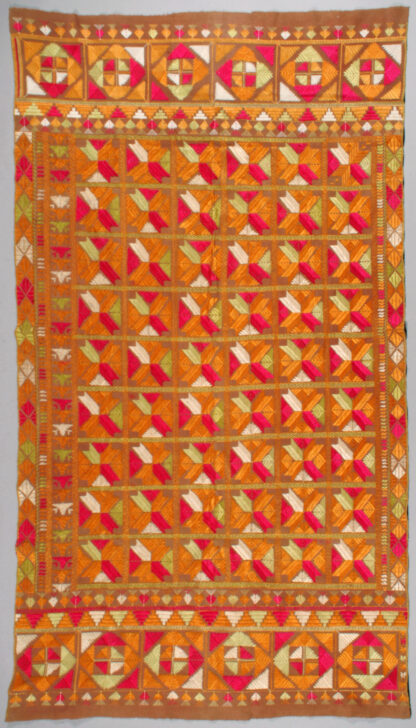Phulkari shawl with stylized floral patterns
Indian

Description
The Punjab region is known for these brilliant phulkari embroideries that can function as head coverings, wall hangings, or dresses. Phulkari means “flower working,” which was the name given to them for their beautiful and intricate embroidered designs. A folk art handed down among females for generations, young girls would begin learning phulkari from their mothers, often participating in stitching circles with the village women.
Phulkari use stylized designs of objects from daily life, particularly flowers and birds. These designs usually leave ample space between them, allowing for vibrant patches of fabric to show through. The most common color of the cloth that serves as a base for phulkari embroidery is brick red, as red is an auspicious color associated with shakti (power) and the mother goddess. For a momentous occasion like a wedding the entire surface of the phulkari would be covered with embroidery. This special type of phulkari is called a bagh. From the time a young girl begins to learn phulkari, she hones her skills and works towards creating her own wedding bagh. It is said that a young woman embroidering a puhlkari would stitch into it her hopes and dreams for marriage. The tradition of phulkari embroidery nearly faded out in the late twentieth century, yet the designs have become a recent international fashion trend.
Fall 2010 Gallery Rotation - Natsu Oyobe April 2010
Gallery Rotation Fall 2010
Phulkari with stylized floral patterns
India, Eastern Punjab
First half of 20th century
Homespun cotton cloth with silk embroidery
Anonymous gift in honor of Karuna and Brijen Goswamy, 2005/2.10; Anonymous
Phulkari shawl with stylized floral patterns
India, Eastern Punjab
1st half of 20th century
Silk embroidery on homespun cotton cloth
Gift of Professor Walter M. and Nesta R. Spink in honor of Karuna and
Brijen Goswamy, 2005/2.10
Subject Matter:
Phulkari embroidery uses stylized designs of objects from daily life, particularly flowers and birds. These designs usually leave ample space between them, allowing for vibrant patches of fabric to show through. The most common color of the cloth that serves as a base for phulkari embroidery is brick red, as red is an auspicious color associated with shakti (power) and the mother goddess. The tradition of phulkari embroidery nearly faded out in the late twentieth century, yet the designs have become a recent international fashion trend.
Physical Description:
This piece of brick red cloth is covered with geometric patterns in tones of red, greenish yellow, white and orange. Along the top and bottom edges (if the piece were vertical) are border grids made up of 6 squares with triangular patterns of thread inside them. The main body of the phulkari is a 6 by 9 square grid, each box housing a stylized floral pattern made from embroidery.
Usage Rights:
If you are interested in using an image for a publication, please visit https://umma.umich.edu/request-image/ for more information and to fill out the online Image Rights and Reproductions Request Form.